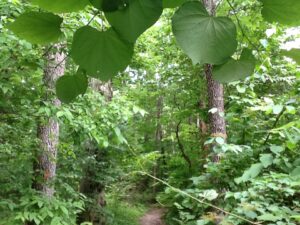By Wren Smith
Wherever I am, the landscape speaks to me. I find familiar friends among the plants and animals I encounter. This week’s walk on the Bent Twig Trail was no exception. I was greeted by chickadees flitting about in the understory of spicebush trees and a pair of wrens scolding me from the branches of a downed cedar tree. Gold and ruby light shone through the turning leaves of the tuliptrees and sassafras. Spicebush berries were beginning to turn from red to brown, and the tapestries of the orb weaving spiders shimmered in the dappled light. Having some knowledge of what (or who) I encounter adds richness to my wanderings.
 Getting to know new friends often begins with learning their names. Slowly, their stories unfold, some of their stories become entwined with our own. This is true for the stories hidden in the land. Ecologist and writer, Gary Paul Nabhan suggests that we “re-story” the land by making it a part of our story, our seasonal celebrations, our community gatherings and festivals. It is easier to protect places that are imbued with familiar and cherished stories. Most Americans can identify thousands of brand names and logos but fewer than 10 common plants in their own backyards. Learning the names provide the key that unlocks stories. Stories may be personal and connected with family reminiscence, historical, or ecological. Stories help us create or uncover layers of meaning. They help us feel rooted to the land.
Getting to know new friends often begins with learning their names. Slowly, their stories unfold, some of their stories become entwined with our own. This is true for the stories hidden in the land. Ecologist and writer, Gary Paul Nabhan suggests that we “re-story” the land by making it a part of our story, our seasonal celebrations, our community gatherings and festivals. It is easier to protect places that are imbued with familiar and cherished stories. Most Americans can identify thousands of brand names and logos but fewer than 10 common plants in their own backyards. Learning the names provide the key that unlocks stories. Stories may be personal and connected with family reminiscence, historical, or ecological. Stories help us create or uncover layers of meaning. They help us feel rooted to the land.
Greenbrier (Smilax roundifolia) in the photo above, is common on the Bent Twig Trail. It is a native vine that grows throughout Bernheim. Greenbrier provides important browse for deer and other mammals. Another species of Smilax has such an abundance of spines that people gave it the common name blaspheme vine due to the tendency of language to run afoul when folks became entangled in it.
This little aster (Symphyotrichum pilosum) grows along the sunny edge of this trail. There are many species in the genus, but the common name makes sense. Notice the resemblance to little stars? See the connection between the name aster as in astronomy, astrology, or astronaut? These little stars are some of the last fall blooms providing pollen and nectar to bees.
Naming and identifying the creatures and features in our landscape doesn’t just add enrichment. Such knowledge provides us with the ability to monitor biodiversity that is essential for the health of our natural communities. If we don’t know what something is, we may not know if it’s a capstone species (one that many other species depend on) or if that particular species in in decline. We may also not even recognize if what we are observing is an invasive species such as wintercreeper (Euonymus fortunei) threatening the health of an ecosystem.

Observation is often the first step to learning more about that which we are observing, and the broader landscapes of our lives. Our observations lead to deeper levels of knowing that go beyond the name. Layers of knowledge that may have as much to do with stories as with science, perhaps a dance between science and stories.
The places, the plants, and animals have stories worth knowing and sharing. They need storytellers. Start asking the question, “what is it?”, or if you prefer, “who is this?” If you are willing to look and listen, the stories will follow. Just remember stories are meant to be retold.
Want more Tales from Bent Twig? Click here to view the archive.



